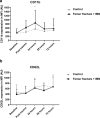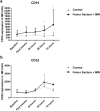Standardized porcine unilateral femoral nailing is associated with changes in PMN activation status, rather than aberrant systemic PMN prevalence
- PMID: 34114052
- PMCID: PMC9192391
- DOI: 10.1007/s00068-021-01703-2
Standardized porcine unilateral femoral nailing is associated with changes in PMN activation status, rather than aberrant systemic PMN prevalence
Abstract
Purpose: Intramedullary nailing (IMN) of fractures is associated with increased rates of inflammatory complications. The pathological mechanism underlying this phenomenon is unclear. However, polymorphonuclear granulocytes (PMNs) seem to play an important role. We hypothesized that a femur fracture and standardized IMN in pigs is associated with altered appearance of PMNs in circulation and enhanced activation status of these cells.
Methods: A porcine model including a femur fracture and IMN was utilized. Animals were randomized for control [anesthesia + mechanical ventilation only (A/MV)] and intervention [A/MV and unilateral femur fracture (FF) + IMN] conditions. PMN numbers and responsiveness, integrin (CD11b), L-selectin (CD62L) and Fcγ-receptor (CD16 and CD32)-expression levels were measured by flowcytometry of blood samples. Animals were observed for 72 h.
Results: Circulatory PMN numbers did not differ between groups. Early PMN-responsiveness was retained after insult. PMN-CD11b expression increased significantly upon insult and peaked after 24 h, whereas CD11b in control animals remained unaltered (P = 0.016). PMN-CD16 expression levels in the FF + IMN-group rose gradually over time and were significantly higher compared with control animals, after 48 h (P = 0.016) and 72 h (P = 0.032). PMN-CD62L and CD32 expression did not differ significantly between conditions.
Conclusion: This study reveals that a femur fracture and subsequent IMN in a controlled setting in pigs is associated with enhanced activation status of circulatory PMNs, preserved PMN-responsiveness and unaltered circulatory PMN-presence. Indicating that monotrauma plus IMN is a specific and substantial stimulus for the cellular immune system. Early alterations of circulatory PMN receptor expression dynamics may be predictive for the intensity of the post traumatic response.
Keywords: Activation status; Inflammation; Intra-medullary nailing; Polymorphonuclear neutrophils; Porcine modelling.
© 2021. The Author(s).
Conflict of interest statement
M.T./R.P. have received research grants (as mentioned previously). All other authors (K.H., T.S., T.B., Y.K. F.H., L.K., H.P., L.L. declare that they have no conflict of interest.
Figures




References
-
- Pape HC, Auf'm'Kolk M, Paffrath T, et al. Primary intramedullary femur fixation in multiple trauma patients with associated lung contusion–a cause of posttraumatic ARDS? J Trauma. 1993;34(4):540–547. - PubMed
-
- Pfeifer R, Heussen N, Michalewicz E, et al. Incidence of adult respiratory distress syndrome in trauma patients: a systematic review and meta-analysis over a period of three decades. J Trauma. 2017;83(3):496–506. - PubMed
-
- Hietbrink F, Koenderman L, van Wessem KJP, et al. The impact of intramedullary nailing of tibia fractures on the innate immune system. Shock. 2015;44(3):209–214. - PubMed
-
- Abraham E. Neutrophils and acute lung injury. Crit Care Med. 2003;31(4 Suppl):S195–S199. - PubMed
-
- Maier B, Lefering R, Lehnert M, et al. Early versus late onset of multiple organ failure is associated with differing patterns of plasma cytokine biomarker expression and outcome after severe trauma. Shock. 2007;28(6):668–674. - PubMed
MeSH terms
Grants and funding
LinkOut - more resources
Full Text Sources
Medical
Research Materials
Miscellaneous

